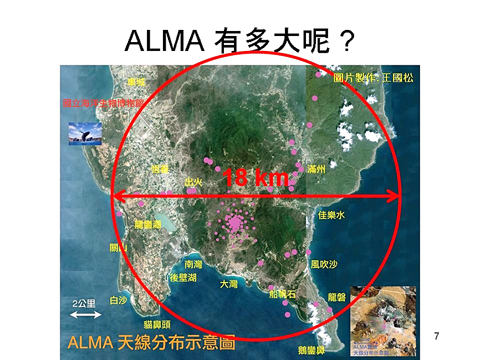Answers to some of the astronomy world’s long-debated questions — such as the formation and structure of stars and galaxies when the universe was young — may soon be unveiled thanks to a groundbreaking collaboration involving Taiwanese astronomers, the National Science Council (NSC) said in a press conference yesterday.
The Atacama Large Millimeter/submillimeter Array (ALMA) observatory, a space telescope composed of 66 giant antennas scheduled for completion in 2012, and one of the world’s most advanced tools for exploring cooler parts of outer-space is almost complete, the NSC said.
The telescope — a collaboration between US, Canadian, EU, Japanese and Taiwanese scientists — successfully observed Mars in a “test drive” on April 30, ALMA project scientist Lu Sheng-yuan (呂聖元) said.

PHOTO PROVIDED BY LIU SHENG-YUAN OF ACADEMIA SINICA
“This is a milestone for the extremely complex project — being in Chile’s Atacama desert 5,000m above sea level and involving so many mechanical components,” Lu said. “[Since 1995] we worked on producing, transporting and assembling the antennas, but we didn’t know if we would really see astronomical bodies through [the telescope].”
Taiwan’s contribution to the project — besides US$32 million in funding — is the development of the antennas, as well as the “front end,” the first electronic element through which the signals from space are received, Lu said.
The revolutionary space telescope is an interferometer, meaning that information collected by two or more of the antennas are processed into a single, high-resolution system, Lu said.
In the April 30 observation, two of the three completed antennas were spaced about 30m apart to collect signals from Mars, Lu said.
“This is kind of like detecting a person’s location from listening: With one ear, it is difficult to detect where the person is talking from, but with two it is easier,” he said.
When all 66 antennas are completed, the distance between them will be able to be adjusted according to the resolution the scientists desire, Lu said.
“The longer the distance between two antennas, the better the resolution, but the smaller a region we can observe. The maximum distance two antennas can be placed apart is 18km, which would simulate the effect of a [traditional] telescope 18km in diameter,” he said.
In addition to being very high resolution, the wavelengths that the antennas detect enable scientists to observe cooler parts in the universe, meaning galaxies and stars that are at early stages in their formation, Lu said.
“This means we can explore the formation of them, and confirm or reject current theories,” he said.
As for the future of the project, Lu said that Taiwanese researchers are entitled to up to 60 percent of the telescope’s observation time when it is completed, pending researchers submitting good proposals.
However, he is optimistic that the nation’s scientists can get sufficient time with ALMA: “Though we are a young team, I don’t think our [quality of research] would be worse than other countries.”

“China is preparing to invade Taiwan,” Deputy Minister of Foreign Affairs Francois Wu (吳志中) said in an exclusive interview with British media channel Sky News for a special report titled, “Is Taiwan ready for a Chinese invasion?” the Ministry of Foreign Affairs said today in a statement. The 25-minute-long special report by Helen Ann-Smith released yesterday saw Sky News travel to Penghu, Taoyuan and Taipei to discuss the possibility of a Chinese invasion and how Taiwan is preparing for an attack. The film observed emergency response drills, interviewed baseball fans at the Taipei Dome on their views of US President

The Central Weather Administration (CWA) today issued a "tsunami watch" alert after a magnitude 8.7 earthquake struck off the Kamchatka Peninsula in northeastern Russia earlier in the morning. The quake struck off the east coast of the Kamchatka Peninsula at 7:25am (Taiwan time) at a depth of about 19km, the CWA said, citing figures from the Pacific Tsunami Warning Center. The CWA's Seismological Center said preliminary assessments indicate that a tsunami could reach Taiwan's coastal areas by 1:18pm today. The CWA urged residents along the coast to stay alert and take necessary precautions as waves as high as 1m could hit the southeastern

ECONOMIC BENEFITS: The imports from Belize would replace those from Honduras, whose shrimp exports have dropped 67 percent since cutting ties in 2023 Maintaining ties with Taiwan has economic benefits, Ministry of Foreign Affairs officials said yesterday, citing the approval of frozen whiteleg shrimp imports from Belize by the Food and Drug Administration (FDA) as an example. The FDA on Wednesday approved the tariff-free imports from Belize after the whiteleg shrimp passed the Systematic Inspection of Imported Food, which would continue to boost mutual trade, the ministry said. Taiwan’s annual consumption of whiteleg shrimps stands at 30,000 tonnes, far exceeding domestic production, the ministry said. Taiwan used to fill the gap by importing shrimps from Honduras, but purchases slumped after Tegucigalpa severed diplomatic ties with Taiwan

The Executive Yuan yesterday approved a southwestern extension of the Sanying MRT Line from New Taipei to Bade District (八德) in Taoyuan, with a goal of starting construction by late 2026. The 4.03-kilometer extension, featuring three new stations, will run from the current terminus at Yingtao Fude Station (LB12) in New Taipei City to Dannan Station (LB14), where it will connect with Taoyuan’s Green Line, New Taipei City Metro Corp said in a statement. This extension will follow the completion of core Sanying Line, a 14.29-kilometer medium-capacity system linking Tucheng (土城), Sansia (三峽)